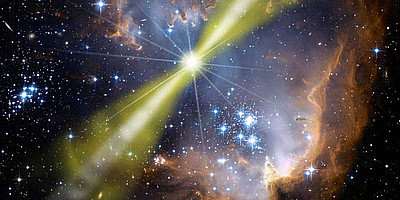Detecting Cosmic Rays from South America

We have been aware of the existence of Cosmic Rays for more than a century, and they have been observed with very high energy. In 2012, NASA discovered the origin of low energy cosmic rays. However, the origin of higher-energy cosmic rays, still remains a mystery to us. Now, Dr. Takashi Sako, member of the Institute for Cosmic Ray Research from the University of Tokyo, Japan, is promoting a project related to seeking the origin of high energy cosmic rays. Dr. Sako visited Yachay Tech University last week to talk about Cosmic Rays Origin and his project; here is what he told us.
What is a Cosmic Ray exactly? Cosmic Rays are, in simple terms, very high-energy protons and atomic nuclei striking Earth from outer space. Cosmic Rays are considered to originate in Supernovae. A Supernova is a stellar explosion generated by the rupture of the gravitational course and the conclusion of the nuclear fusion cycle of a gigantic star. This explosion generates something called “supernova remnant”, which is formed by the expanding material from the event.
When this explosion takes place, Cosmic Rays emerge. From the theoretical point of view, it has long been believed that cosmic rays are accelerated in the shock wave of the supernova remnant. However, given that cosmic rays have an electric charge, when traveling through space, different magnetic fields attract them, interrupting their trajectory. This is the reason why the origin of Cosmic Rays is very difficult to identify. Lets say, if a projectile object curves and twists many times behind your vision camp and then circles in front of you, finally hitting you in the face; you would probably think it came from your front instead of your back. Likewise, with Cosmic Rays, this is a major problem when trying to trace their trajectory back to its origin.
Therefore, to find the source from which Cosmic Rays come, alternative measuring is needed. The interaction between Cosmic Rays and ambient matter around the source can produce a particle called Neutral Pion. This particle immediately decays into gamma-ray photons, which do travel a straight line pattern through the space toward us. Therefore, calculating their source is a simpler process. To detect these gamma rays and thus identify the origin of cosmic rays, astronomers should observe cosmic gamma rays with a specific rate of energy, because it is an indicator that they are produced by a Neutral Pion. NASA’s Fermi Large Telescope successfully detected these gamma rays from two supernova remnants in 2012, thus providing the experimental evidence that supernova remnants are the origin of cosmic rays with relatively low energies. However, where and how cosmic rays gain high energies has yet to be revealed by future experiments.
Specifically, Dr. Sako is actively promoting the ALPACA project. ALPACA stands for Andes Large area PArticle detector for Cosmic ray physics and Astronomy. The overall objective of the project is the construction of a Cosmic and Gamma Ray observatory in Bolivia. One of the main reasons for the project’s location is that the south position observation can be opposed to the north position observation of the Cosmic Ray observatory in Mexico, giving a wider range of data to analyze. Dr. Sako also expects to collaborate with Yachay Tech in the near future as he finds the university interesting and a great opportunity for astronomical research in South America.
The main importance of understanding Cosmic Rays lies in the great amount of energy they can transport, up to 300 000 000 TeV (Tera Electron Volts). This is important for two reasons: it may shed some light on how high-energy phenomena in the universe affect us and, in a possible future, understanding how to control that amount of energy.
—
Dr. Sako has worked on the Tibet ASg Experiment for approximately 11 years. This experiment, conducted with the Institute for Cosmic Ray Research from the University of Tokyo, Japan, is similar to the ALPACA project. Located on Tibet, this observatory has an altitude of 4300 meters above sea level. He has a great amount of experience analyzing the phenomena regarding cosmic-ray physics and astrophysics. During his doctoral years he studied Cosmic Ray anisotropy to create an image on how the magnetic fields interacting with Cosmic Rays work. At the conclusion of his study he proposed a new model for the flows of cosmic rays through the magnetic structures of our immediate universe.
References
Berezinskii, V. S., Bulanov, S. V., Ginzburg, V. L., Dogel, V. A., & Ptuskin, V. S. (1984). The astrophysics of cosmic rays. Moscow, Izdatel’stvo Nauka, 1984, 360 p. In Russian., 1.
CENTER, G. A. F. (1967). COSMIC RAY ANISOTROPIES AND THE INTERPLANETARY MAGNETIC FIELD.
Wootten, H. A. (1977). The molecular cloud associated with the supernova remnant W44. The Astrophysical Journal, 216, 440-445
Ackermann, M., Ajello, M., Allafort, A., Baldini, L., Ballet, J., Barbiellini, G., … & Blandford, R. D. (2013). Detection of the characteristic pion-decay signature in supernova remnants. Science, 339(6121), 807-811.